Béchamel or white sauce is one of the five main sauces in French cuisine. It is a versatile sauce because it is served with fish, vegetables and meat dishes. It perfectly complements and at the same time unobtrusively enhances the taste of almost any dish, adding a delicate and velvety texture.
According to one version, it was hastily invented during a royal reception at the court of Louis XIV. The Marquis Louis de Béchamel, who managed the palace, found cod on one of the plates, which, in his opinion, “was not ready for presentation”.
There was little time before serving, and the courtier, who loved culinary experiments, replaced softened bread in one of the recipes with roux – flour fried in butter until golden in color (roux in French means golden, red).
Since then, the sauce that immortalized the Marquis’s name has been on the menus of many restaurants around the world.
In addition, béchamel is the basis for other sauces, and over three thousand varieties of other sauces are made on it!
To make béchamel, you only need three ingredients that you probably have in your kitchen. They are flour, butter and milk.
But I’ll also show you how you can diversify the flavor of the sauce by adding another classic French flavor additive to it: onion clouté.
Despite its apparent simplicity, people often find it difficult to make this sauce. For some, it is not homogeneous enough, with lumps; for others, it has an unpleasant smell of flour; for others, it is too liquid or too thick.
I’ve described the recipe for Roux and Béchamel sauce before in the preparation of the chicken wicker puff pastry. But this time I will describe the cooking steps in as much detail as possible, so that you will definitely not encounter any of the described difficulties.
And if you still have questions – ask in the comments, I’ll try to help.
⏱ Cooking time — 20 minutes overall. Includes 10 minutes of preparation and cooking + 10 minutes unattended.
🥣 Ingredients
For Roux:
- 75 g (2,7 oz) first grade wheat flour
- 75 g (2,7 oz) of butter
For Béchamel with onion cluté:
- 500 ml (2,1 cups) milk (regular fat)
- 1 onion
- 5 clove buds
- 1/4 nutmeg
- 1 bay leaf

🔪Step by step Directions
Onion Clute
We start preparing béchamel with onion cluté. In simple terms – an onion with clove buds stuck in it. Sometimes they also attach a bay leaf to it in this way, but I’ll just add it separately, it won’t affect the taste in any way. Later we will add them to the milk and thus make our future béchamel more fragrant and interesting. Onion with bay leaf and cloves, having warmed up, will give their aromas and flavors to the milk.
You may ask, why put cloves in the onion? The answer is simple – no, not for beauty or pathos, but so that after the milk has absorbed the flavors of the spice, it is easier to remove the cloves from the milk by removing them along with the onion, rather than fished all over the pot. And the bay leaf is easy to remove as it is, so you don’t have to pin it to the onion.
Take 1 onion, peel it, cut off the edges with tails. Stick 4-5 clove buds into it.
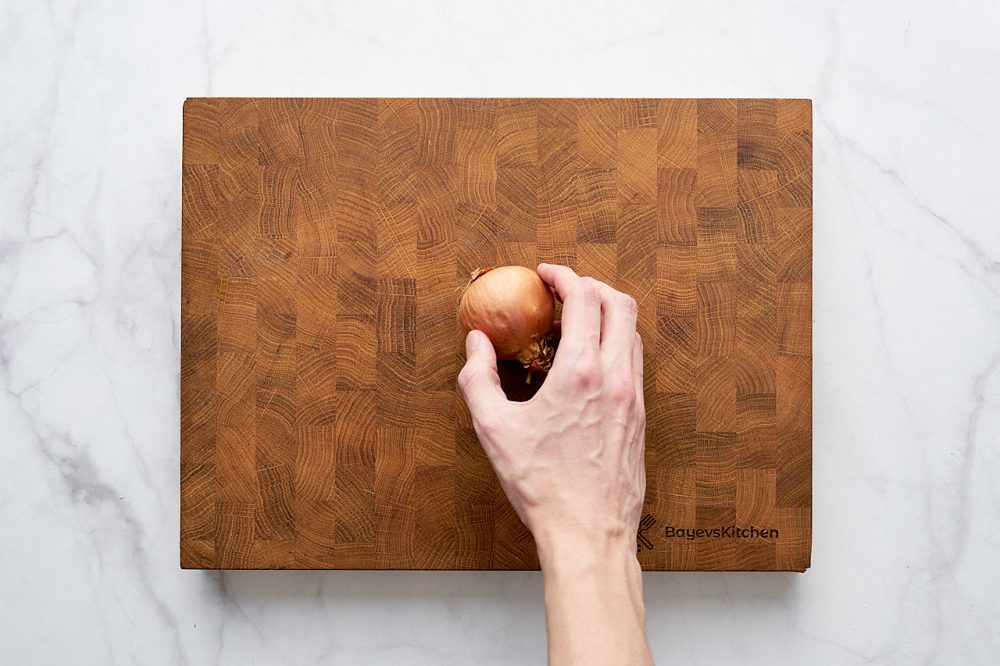
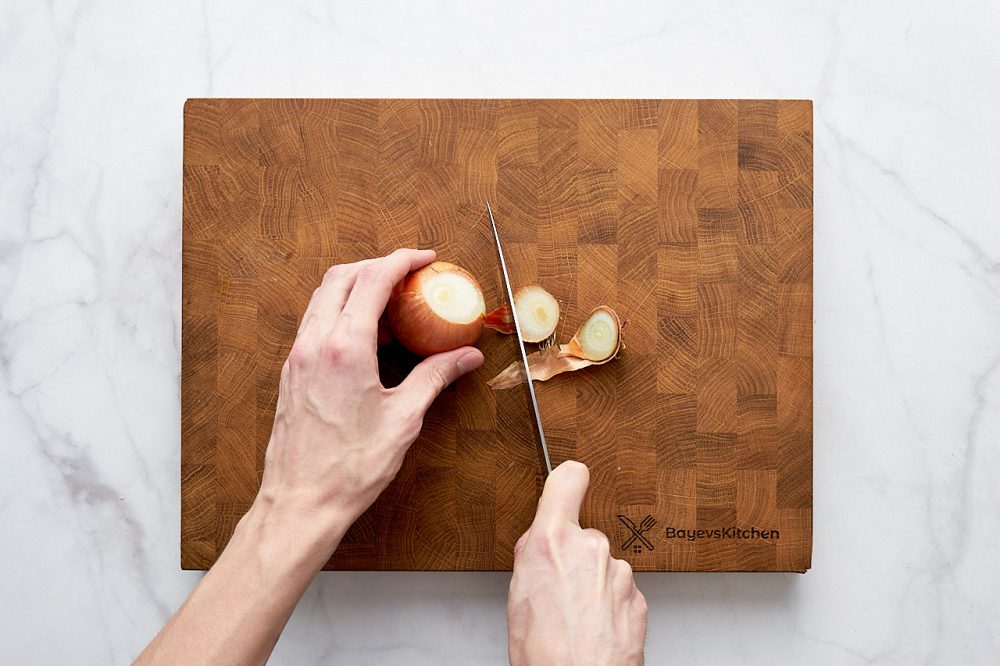
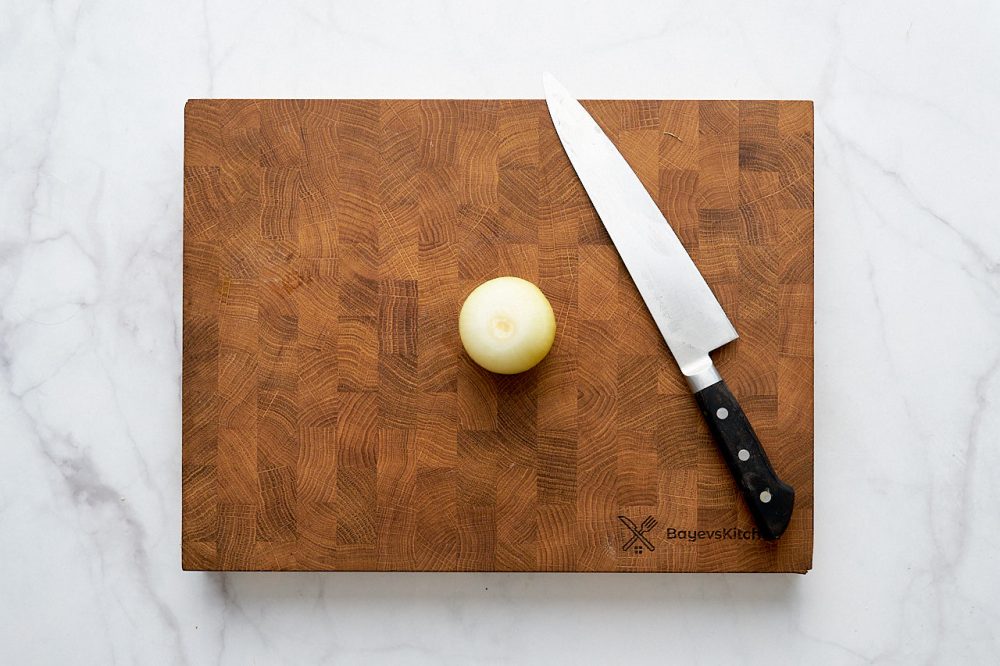

Pour 500 ml (2,1 cups) milk into a saucepan. Put in it the onion and cloves, add 1 bay leaf.
Choose a saucepan that is not too small, so that the onion is completely immersed in milk, or at least three-quarters of it, so it gives off more flavor.
Place the milk and spices over a medium heat and bring to a temperature of 80-90 °C (180-200 °F), stirring occasionally. You do not need to bring it to a full boil, but you do not need to be very precise. If you feel it boiling, remove it. If it boils, there is nothing wrong with it either.
Remove from the heat and leave to infuse for 15 minutes.

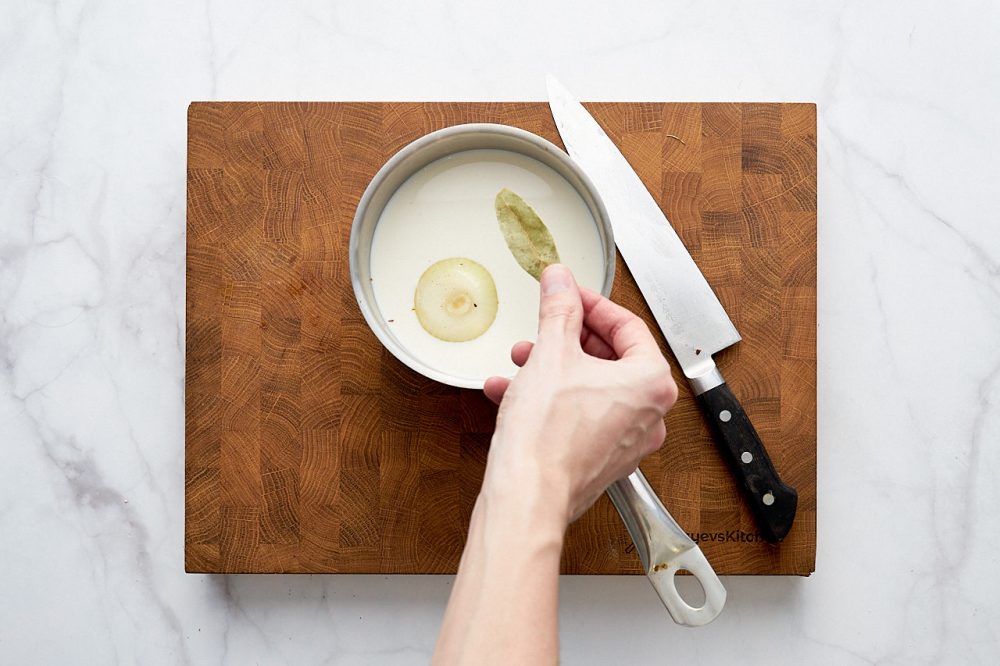
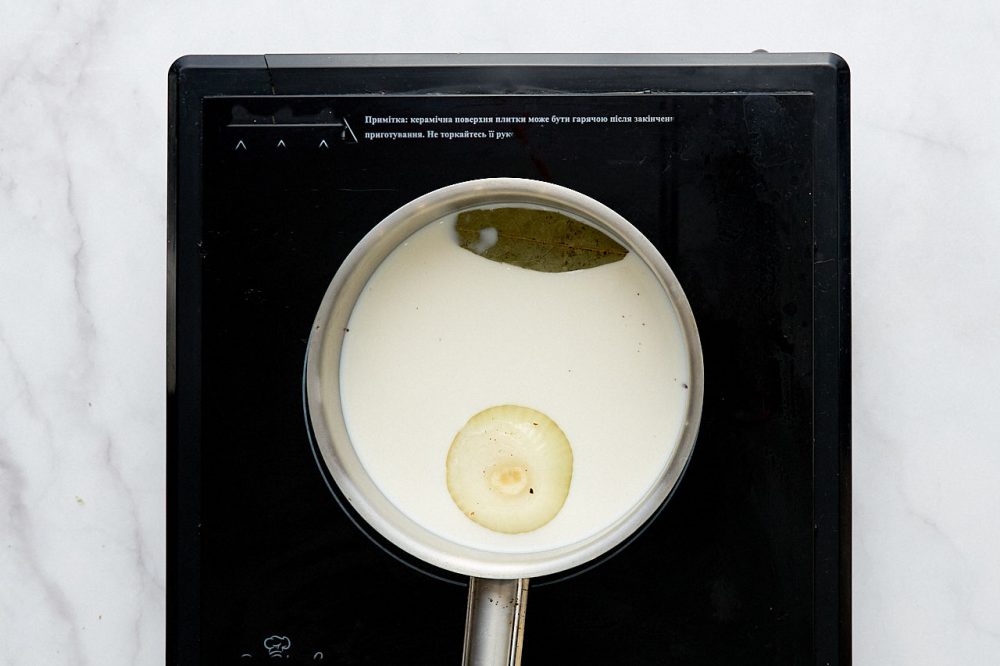
Cooking Roux
While the milk is saturating the flavors, prepare Roux.
Roux is a mixture of flour and oil designed to thicken the future sauce. It can be different, depending on the degree to which the flour is thickened. Béchamel is a white sauce, which means that the flour must be heated very carefully so that it almost does not change its color. It is acceptable for the color of the flour to become creamy, but not brown or burnt. This is necessary to keep our sauce exactly white in color. A more toasted roux is used in other sauces.
To avoid overcooking Roux, I recommend cooking it over a very low heat, especially for beginners. This process will take you longer than if you do it over medium heat, but you won’t overcook the flour.
If you have enough experience and are not afraid of overcooking the flour – turn up the heat, but keep an eye on the degree of toasting. If you see that the flour begins to change color, raise the pan from the fire and let it cool a little out of contact with the stove, remember to stir constantly and stay on the stove.
Roux can be prepared in different ways. Melt the butter and then add the flour, or as I recommend, start with the flour. Both are correct. In this case, the sum doesn’t change from rearranging the sums, but the second way seems simpler to me. Why?
- First, if you overcook or burn the flour, you can throw it away and it’s not too much of a loss. Flour is practically worthless in monetary terms, but throwing away half a packet of butter would be a bit of a shame.
- Second, it is easier to determine the degree of readiness by the color and odor of the flour separately. Butter has its own color and aroma, and they can be misleading.
I am not saying that this is the best way, but in my opinion it is the most convenient.
Take a frying pan, put it on a small or medium heat and pour 75 g (2,7 oz) of flour into it. Constantly stirring with a spatula, toast the flour until the unpleasant flour aroma is gone. To understand this, smell the contents of the pan throughout the process. First, in the middle, and farther and farther away, holding your nose right up to the pan.
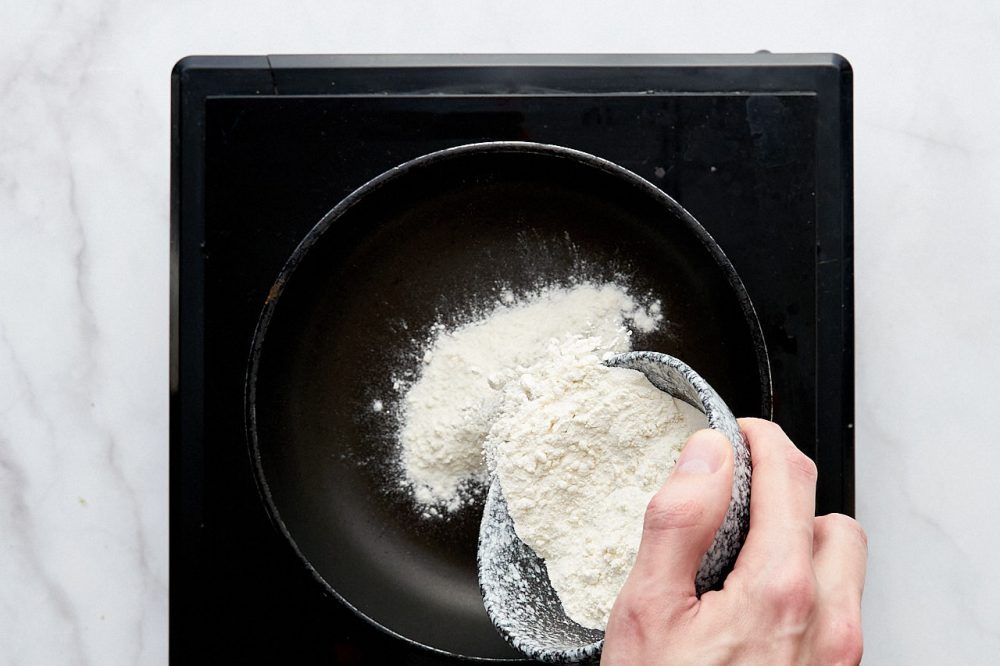
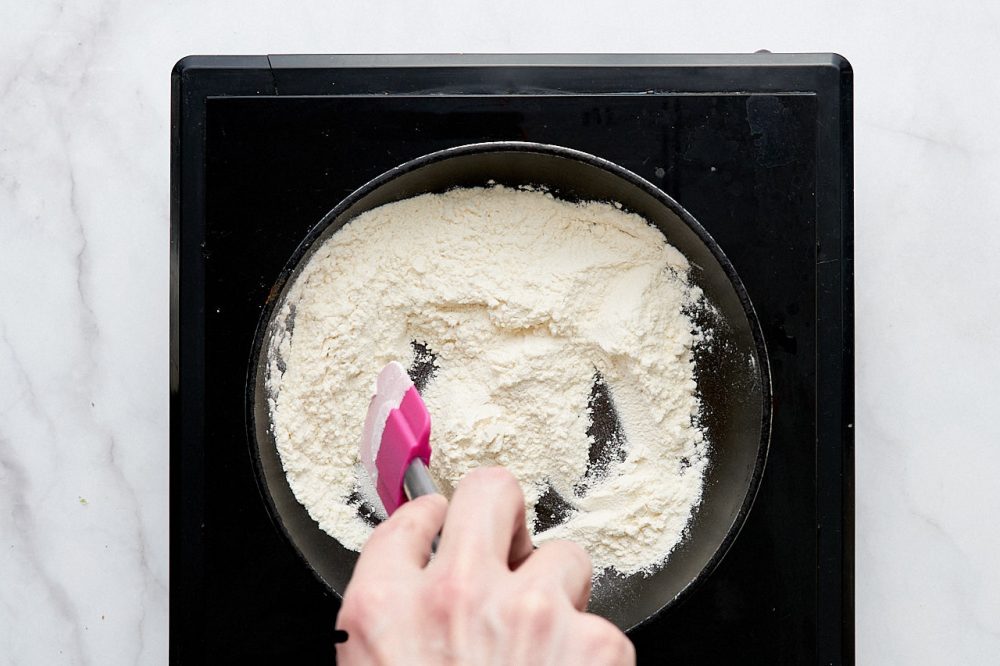

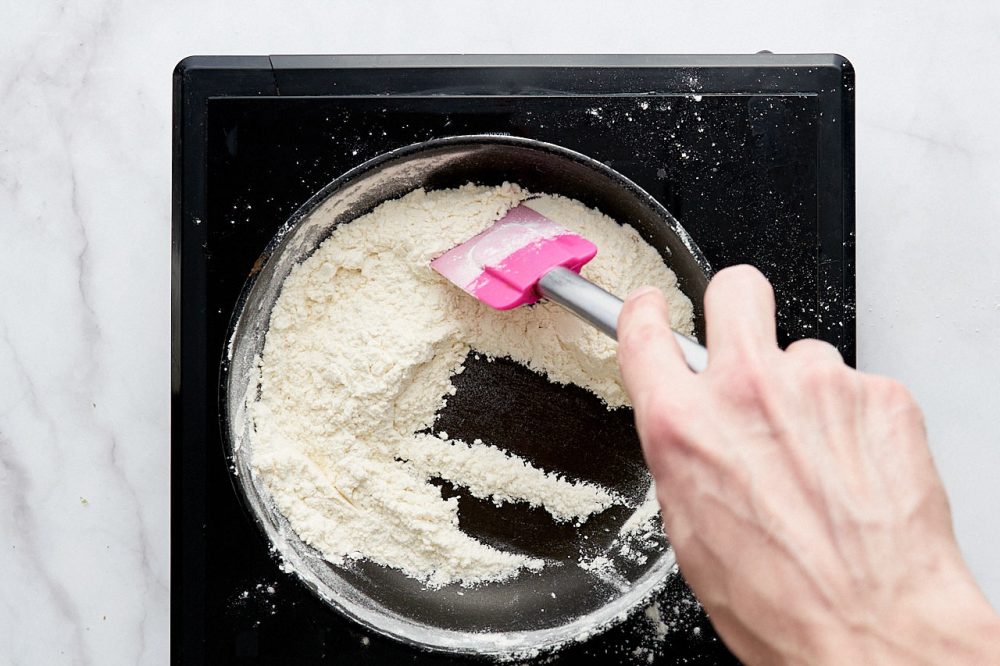
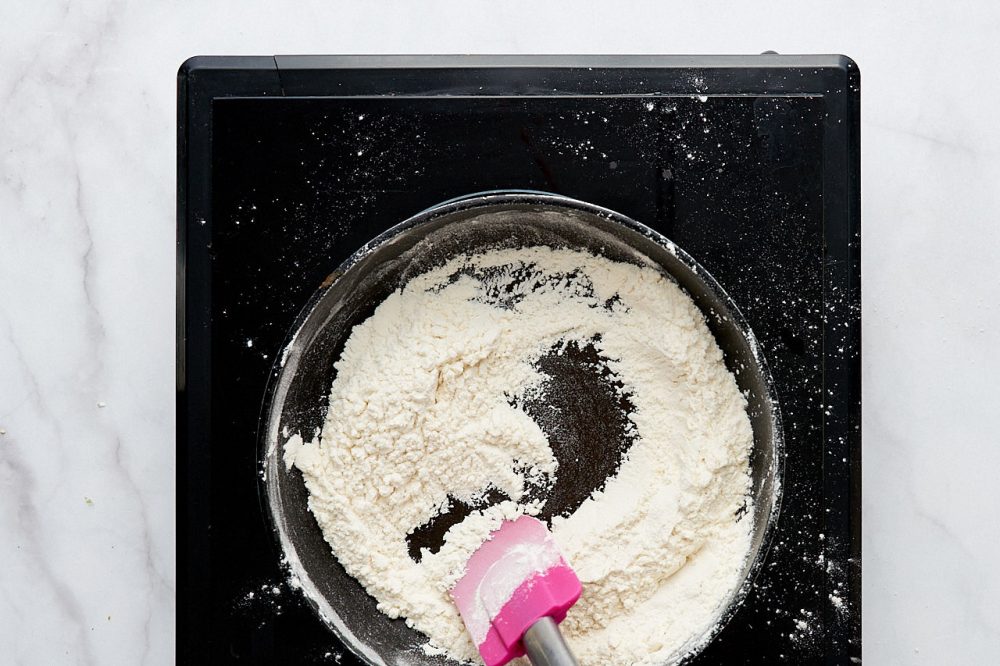
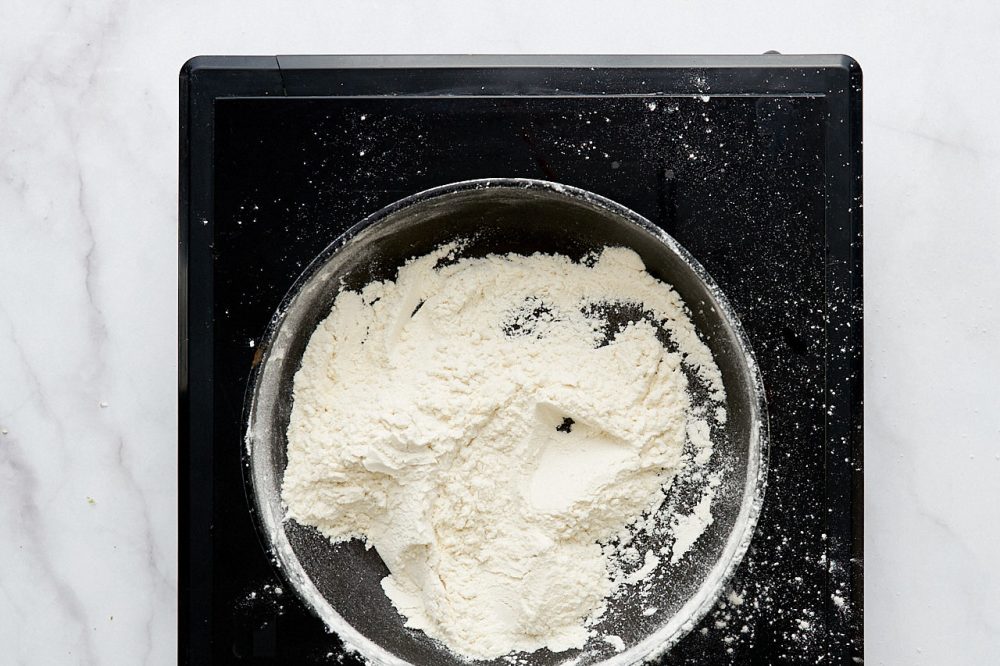
How do you know when the flour is toasted? The unpleasant floury flavor will disappear and a more pleasant aroma of toasted nuts will appear.
To some, this aroma is reminiscent of the smell of toasted almonds. I, on the other hand, would rather call it a light nutty aroma. And it should be pleasant rather than unpleasant. As soon as you hear that aroma, the flour is ready.
Depending on the strength of the heating it will take you from 3 to 7-10 minutes.
When the flour has a pleasant aroma, add 75 g (2,7 oz) of butter to it. Mix with a spatula until homogeneous.
Set aside and return to the milk. Roux is ready. This is enough for several servings of Béchamel. Put the leftovers in the refrigerator, in a thick container or in a bowl, covered with clingfilm. This way it can keep for about a month. For longer storage, freeze it.
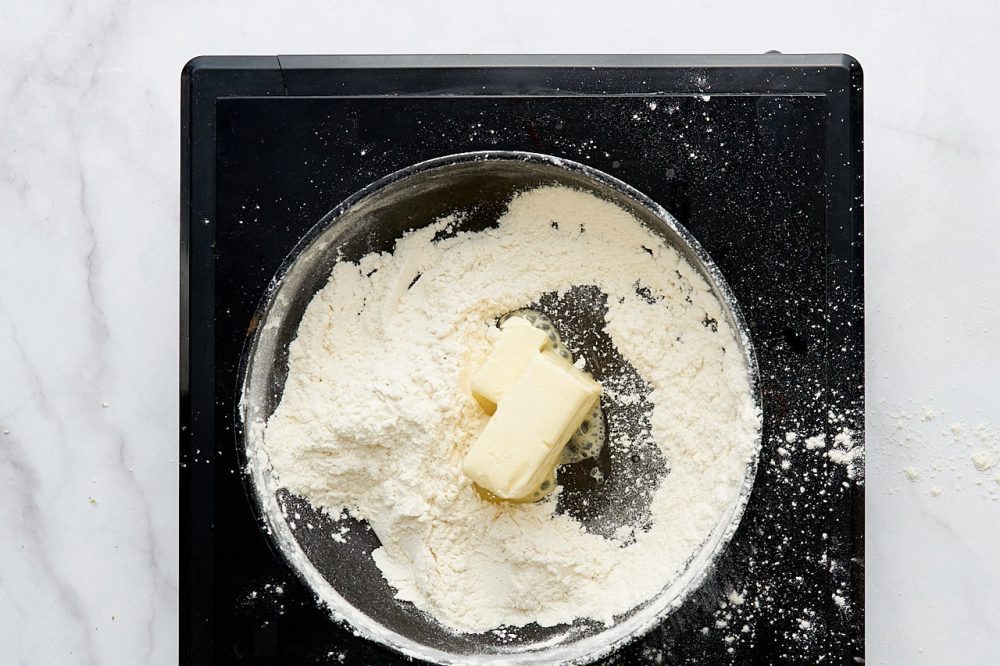
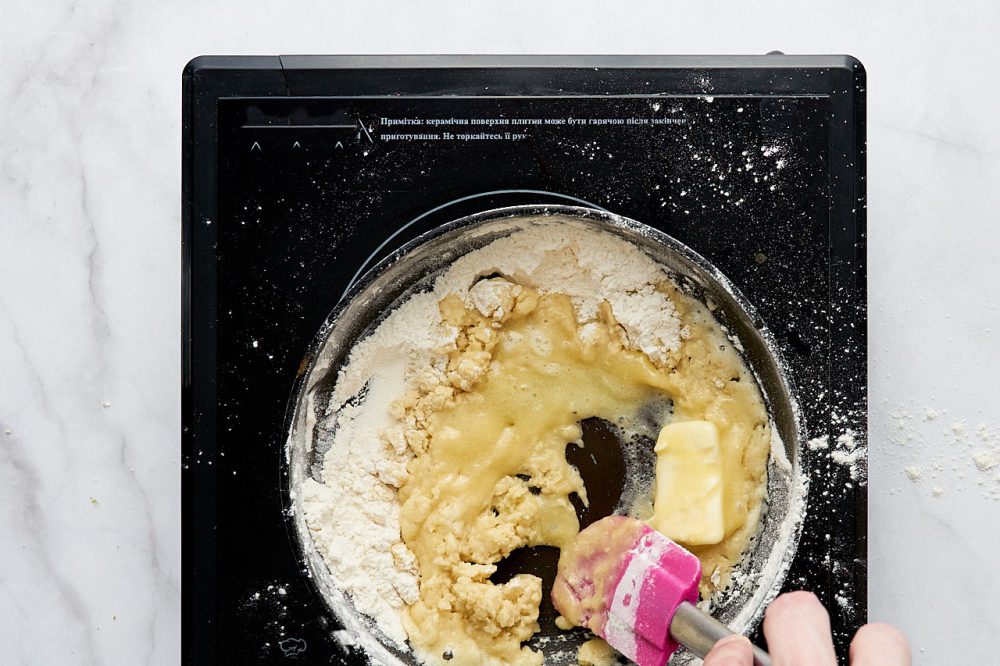

Cooking Béchamel
To make the béchamel sauce, enough Roux and milk. Onion clute is optional. Just like the nutmeg. It is not mandatory, but it is very canonical and very often found in recipes for Béchamel by renowned chefs.
Here we go. If there is a film on the milk, remove it. Take out and discard the onion and bay leaf, they’ve done their job.

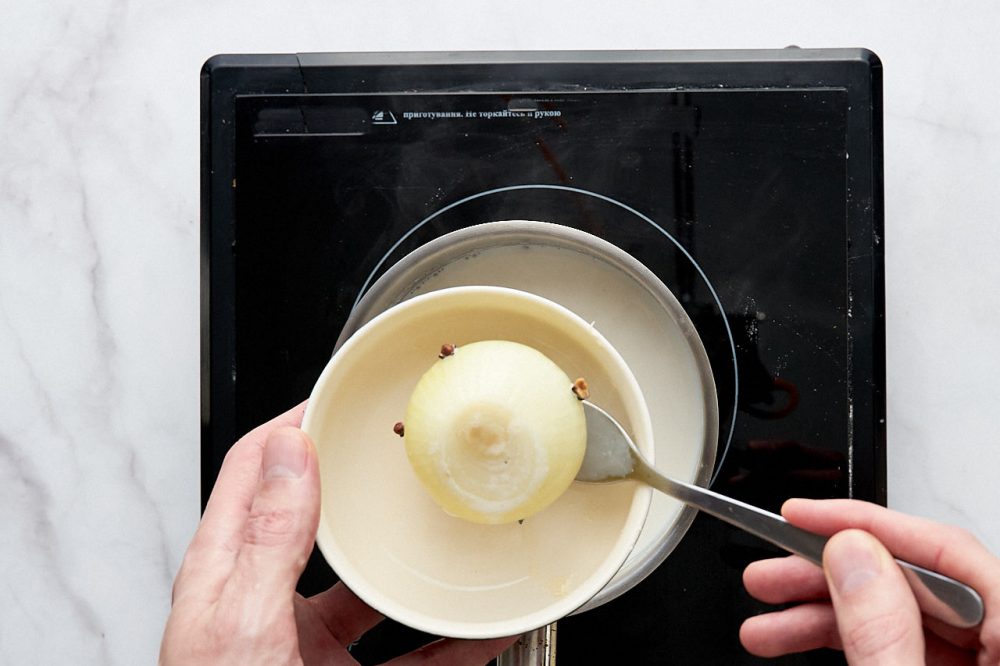
Put the milk in a saucepan on low heat and add to it 1 tbsp. roux. Immediately after adding, start stirring the resulting mixture with a whisk, stir constantly.
This amount of Roux will be enough for 500 ml (2,1 cups) of milk, to make a smooth, not too thick sauce.
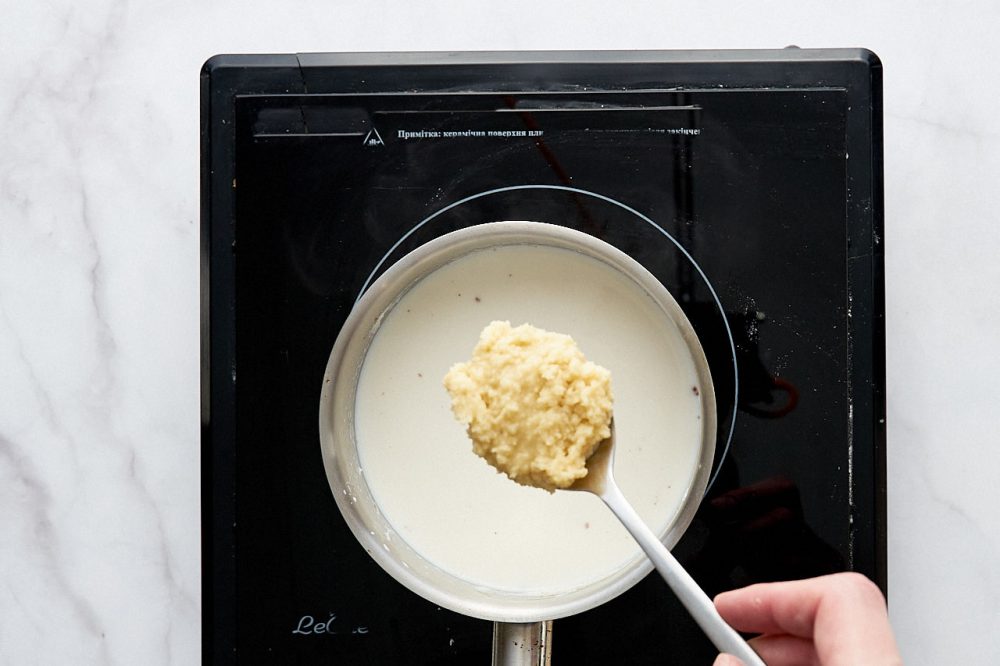

Remember! Until the milk comes to a boil, it won’t start to thicken! And when it boils – it will increase in volume, at this point you need to be very careful that the contents have not escaped from the casserole on the stove.
After the sauce comes to a boil, turn off the heat and keep stirring.
Now you need to assess the resulting consistency of the sauce. If you are satisfied with it – finish cooking, and if not – add about 1/4 teaspoon more Roux and repeat the heating process.
Keep in mind that when the Béchamel sauce cools, it will become thicker. So don’t rush to add Roux to thicken it, wait until the sauce has cooled and assess how thick it is so that it won’t get too thick afterwards. For more on consistency, see the separate section below.
If you are satisfied with the density, add 3/4 tsp. salt and 1/4 tsp. nutmeg. Stir everything and taste, add more salt if needed. It depends on where and how you will use the sauce, so the degree of saltiness is up to you.
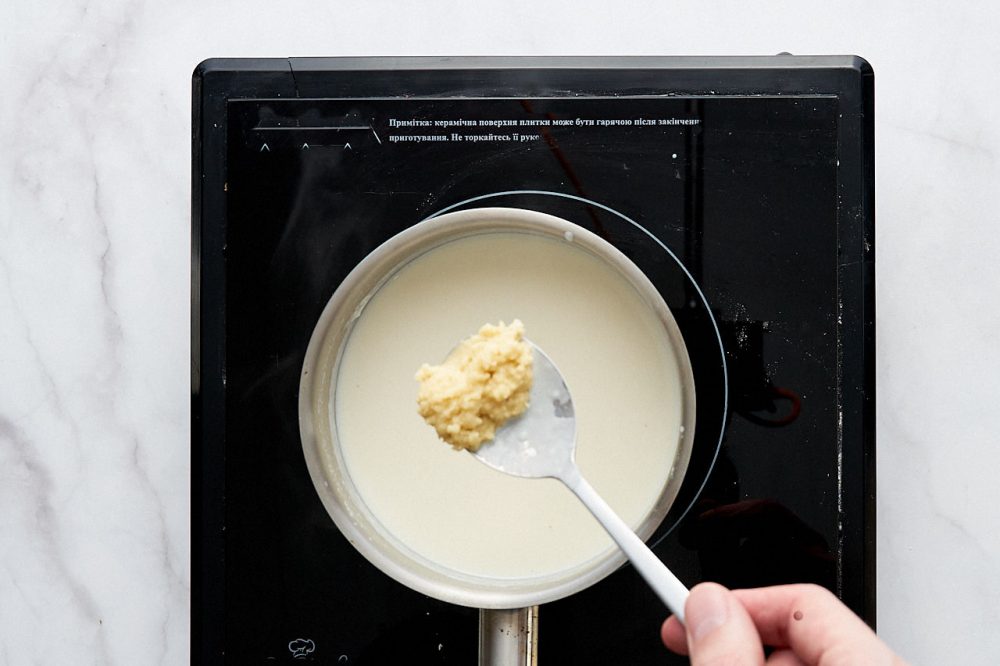

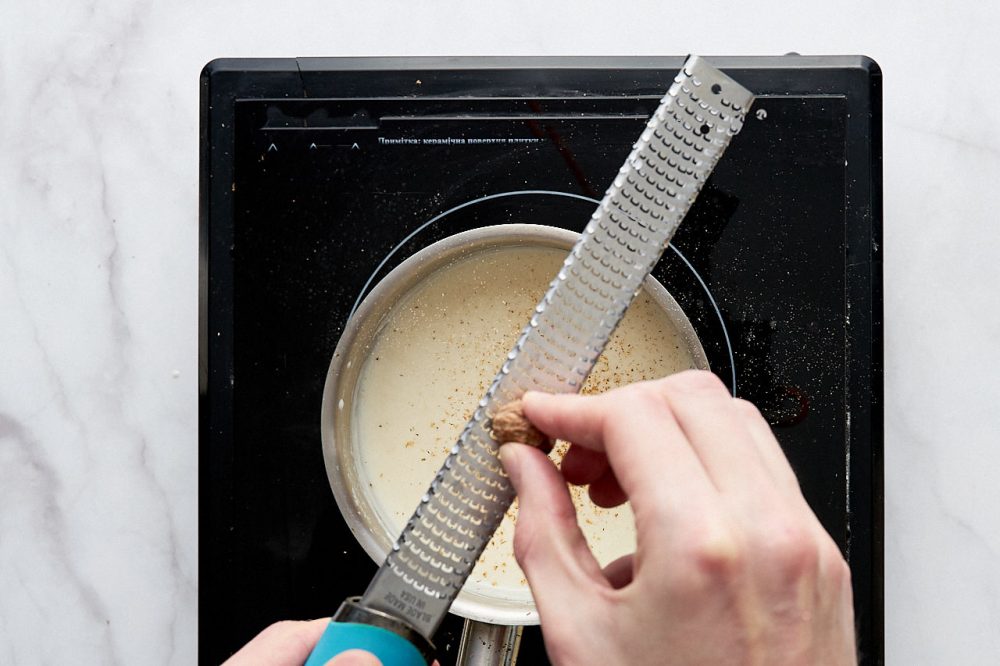

Straining the béchamel sauce.
The process of straining the sauce is not necessary, but it is recommended to do this step so that the sauce is more velvety and homogeneous, and so that the finished sauce is free of spice particles, milk film and other debris.
Take a fine sieve and strain the sauce through it, rubbing it with a spatula.
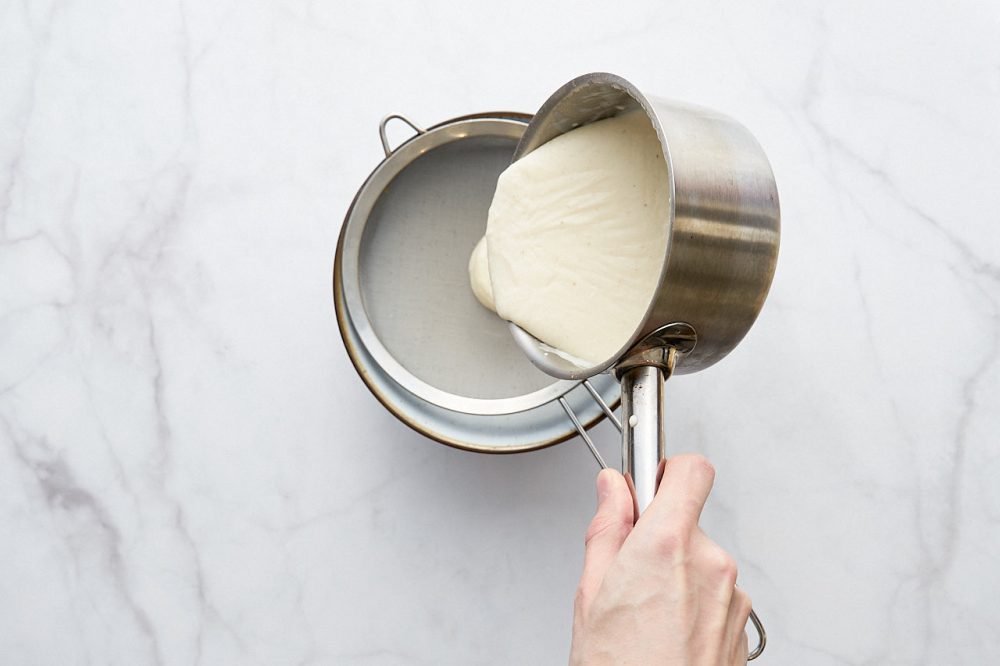

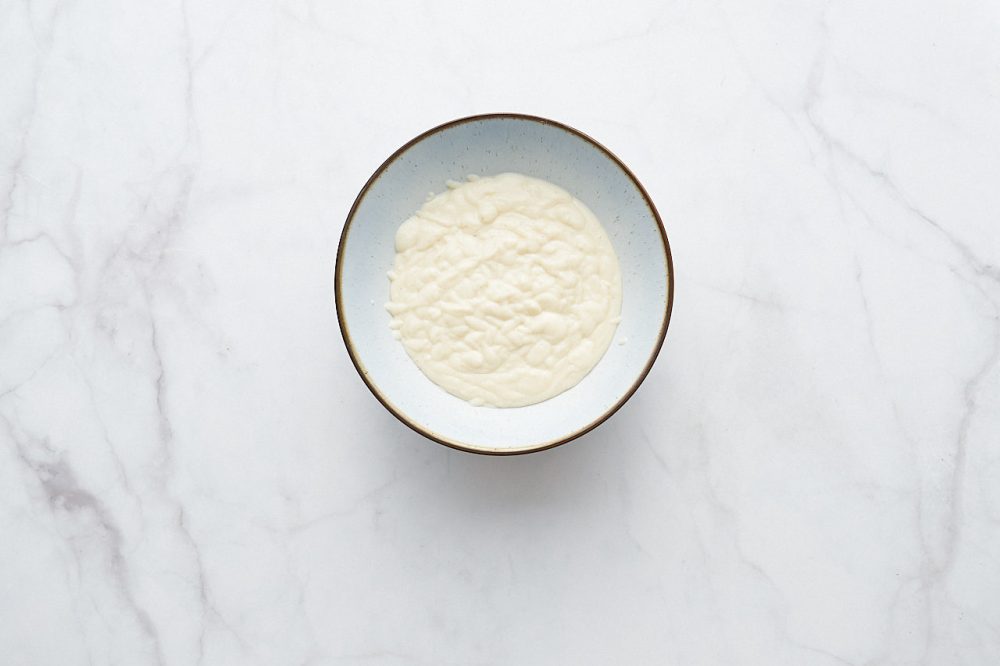
What should be the consistency of béchamel sauce?
To answer this question briefly, the consistency should be – gravy. How do you determine that?
I’ve seen different ways: put a drop of sauce on a plate, if it doesn’t drip, it’s ready. Dip a spoon into the sauce, lift it up, and if it drips thinly, it’s ready. Dip a spoon into the sauce, run your finger along the back of the spoon, if your finger leaves a trail and the sauce envelops the spoon and holds – it’s ready.
All of these tips have their place, but they speak of a state where it is no longer just a liquid, but a sauce. But beyond that, it can be thicker or less thick, and in either of these states pass this “sauce test,” so what should béchamel be?
And here is where there is no right or single answer. It depends on how it will be used next and on your personal preferences. It can be thicker if it is to be served as a sauce and less thick if it is to be used as an ingredient in a dish. Especially if it is to be cooked (e.g., baked), some of the moisture will evaporate and the sauce will become thicker.
In any case, it is worth remembering two things: that béchamel becomes thicker as it cools and that the consistency of the sauce can easily be corrected if you have miscalculated the proportions.
What to do if the sauce is too thick or too liquid?
If the béchamel is too thick
Take a saucepan and transfer the sauce to it. Put the saucepan on low heat and add milk to it (start with 1/10th of the volume). Stir the milk into the sauce and assess the consistency. If the sauce becomes quite fluid – great, if not – add more milk. The main thing is to stir constantly and not to let the sauce boil over too much.
If the béchamel is too runny
Just add a little more Roux, because we made it with a reserve. Put the saucepan on the fire, add some roux and stirring all the time, bring it to the boil. Then take saucepan off fire and estimate the consistency of sauce. If you are satisfied with the consistency of the sauce – fine, if not – add more Roux until you are satisfied with the consistency of the sauce.
Why is it better to cook with stock and in a separate dish?
First of all, as I said earlier, it’s convenient. You have a stockpile of roux to use for making béchamel next time. After all, frying the flour, I think for many people, is the most unloved part of the process.
Secondly, if you cook roux in a saucepan and then pour milk into it, as recommended in most recipes, in case of a mistake and too much milk you will have to cook roux all over again to thicken the sauce more.

How to make Roux and Béchamel with Onion Cluté?

Ingredients
For Roux:
- 75 g first grade wheat flour
- 75 g butter
For Béchamel with onion cluté:
- 500 ml milk (regular fat)
- 1 onion
- 5 buds clove
- ¼ muscat nutmeg
- 1 bay leaf
Instructions
Onion Clute
- Take a peeled onion and stick clove buds in it.
- In a saucepan with milk, put the spiced onion and add the bay leaf. Bring almost to a boil and after turning off the heat, leave for 15 minutes to saturate.
Roux
- In a frying pan over medium heat, toast 75 g of flour until the unpleasant floury flavor is gone. Stir constantly to keep it from burning.
- When the unpleasant flavor of the raw flour changes to a nice nutty flavor, the flour is toasted enough. Add 75 g of butter. Stir until smooth and set aside.
Béchamel
- Remove film from the surface of the milk, if formed. Remove the bay leaf and onion.
- Add 1 tbsp. roux to the milk. Bring to a boil, stirring constantly, turn off the heat and continue to stir. Assess the thickness of the sauce.If you are satisfied with the thickness, add 3/4 tsp. salt and 1/4 tsp. nutmeg. Stir everything and taste, adding more salt if needed.
- Take a fine sieve and strain the sauce through it, rubbing it with a spatula to make the sauce more velvety and uniform. (optional)
